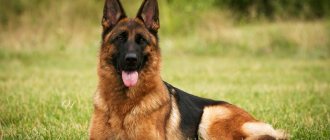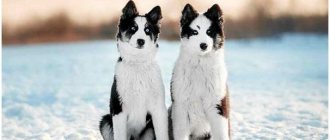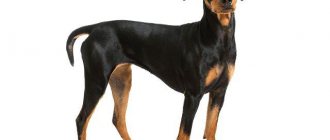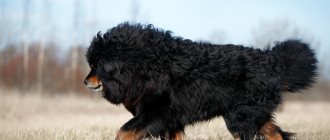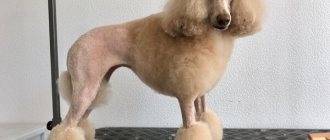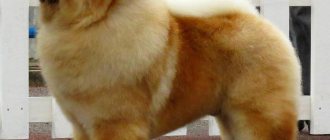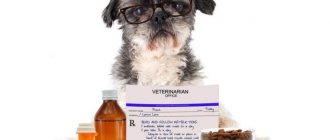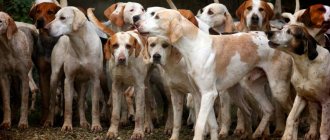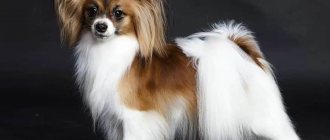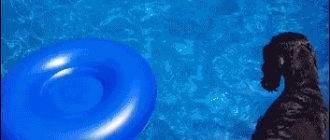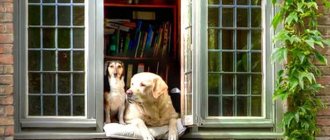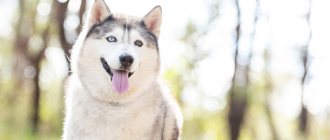Labradors are among the most humane dogs; they are a pet friend, partner, and travel companion.
Labradors are dogs of medium height, they train well, but do not tolerate loneliness well.
Hardy, patient and active pets.
There is a table of sizes that can be used to accurately determine whether everything is in order in the puppy’s development and whether it corresponds to the standard.
How much should an adult pet weigh?
Labradors grow up to a year, after which they practically do not change. Owners only need to worry about maintaining shape.
Labradors are prone to weight gain, and their diet and physical activity must be strictly controlled . Obese dogs experience heart problems.
Labrador boys weigh differently than girls.
For males, the norm is a weight of 28-36 kilograms; for females, a weight from 25 to 33 kilograms is considered normal..
Dimensions (height at withers, etc.) for an adult Labrador, depending on gender
There is an American standard, according to which the height of females is up to 55 centimeters at the withers, males - up to 57 centimeters.
You can measure your dog at home. The breed standards, in addition to general height and weight, include indicators of head length, cheekbone width, length of the body and front legs, chest girth, wrist girth, muzzle length, distance between the shoulder blades, and leg length.
The Labrador is considered a dog of medium height - not very tall and not too small - and quite large in build.
requirements :
- Wedge-shaped large head.
- Powerful muzzle with large nostrils.
- Strong rounded jaws.
- Straight and level nose.
- The eyes are not very big.
- The tail is moderately long, straight, wider at the base and narrower towards the end.
- The hind legs are more developed than the front legs.
If a Labrador's weight exceeds the norm (you can check the size chart and try on the dog yourself at home; on average, an adult dog is about thirty kilograms and half a meter in height), then this cannot be ignored. These dogs have a high appetite, they do not know how to control themselves, and apartment pets most often suffer from obesity. Closer to the age of 10, Labradors become overgrown with fat deposits, this can be avoided if the dog is loaded with physical exercise - running, long walks, swimming - one and a half to two active hours a day. You can check for excess weight by lightly pressing the ribs with your fingers: they should be palpable, but individual ribs should not be visible. If a Labrador does not grow more than forty centimeters for a long time - for example, up to a year - then it is too early to panic, perhaps the dog has not yet matured: adult individuals sometimes grow up to one and a half years.
Purpose
- Hunting or working. The Labrador was also bred from hunting dogs in the Canadian region. A dog has a hunter's instinct, but it needs to be awakened. Fishermen used him as a working dog; now this “profession” is a thing of the past.
- Service. Labrador is a universal dog. She can be trained to serve people and do responsible work. Most often, Labradors become guide dogs and rescue dogs.
- Companion. The friendliest and most loving dog in the world. It becomes a true friend for a person, will accompany the owner everywhere and try to stick his nose into everything. Very reliable and faithful.
Puppy weight and sizes from 1 to 12 months
The weight of newborn Labradors ranges from 40 to 55 grams . Every day they increase to 120 g. From birth to the first month, puppies grow up to 23 centimeters, at three months they reach 40 centimeters, and by six months - 50 centimeters.
Meeting height and weight standards is necessary because this indicates the health of the puppy, as well as its purebred.
At exhibitions where Labradors are examined by experts, the first thing that is done is weighing and other essential measurements.
Therefore, the owner’s responsibility is not only to raise the pet, but also to monitor how it grows in size, strictly following the required diet.
Features of training and education
Dogs of this breed are easy to train. It is important to start the process from early childhood so that the dog has not yet acquired bad habits. It is recommended to entrust this important task to specialists.
Before teaching your dog commands, set your own rules for him in the house. When he clearly begins to follow them, then you can start training. A child can also train a dog if he is over 8 or 10 years old. The nature of the Labrador Retriever does not allow him to use his intellectual abilities only for training, so sometimes the dog is outright cunning in order to do nothing but get what he wants.
Try to keep your dog busy with some small but important activities more often: he can bring you a bag, slippers, a TV remote control, a newspaper, and anything else.
The Labrador loves to swim, so do not limit him in this passion, but use the time wisely: in the water, the dog can also perform the “fetch” command, thereby actively having fun and spending time with its owner.
To raise a sociable dog, you will have to devote the maximum amount of time to him. By trusting you, your pet will not only learn easier and faster, but will also become more joyful and happy.
How to measure height correctly?
You need to use several tools: a centimeter, a ruler, a tape, a square. The height of a dog can be determined by extending a centimeter (tape) along the animal’s body: the end is applied to the floor and extended to the withers.
Height is the distance from the dog's foot to the withers.
Metric information is collected from a standing dog. The animal must be in good spirits and not hungry. The best way to measure a Labrador is at home, in a calm environment; you can cheer him up with a treat.
Gradually the dog will get used to such manipulations and will respond well to them.
The height at the sacrum can be measured with a centimeter (tape, ruler) - from the floor to the highest point of the croup, in maclocs.
To make accurate measurements, the instruments must be placed at the correct points so that they fit against the animal's body, but do not press in. If the hair is long, then to accurately measure growth you need to part the hair and apply a centimeter (ruler, tape) to the skin.
To measure body length, first apply the end of the centimeter to the shoulder, then to the ischial tuberosity. When comparing actual sizes and standards, a special index is used, that is, an indicator of one dog parameter to another.
Growth in this case is the main factor; other results are correlated with it. For example, they distinguish the elongation index (body length to height) and boneiness (carpal girth to height).
IMPORTANT!
Indices allow you to judge whether a four-legged pet meets breed standards.
All data in breed tables are approximate . Sometimes puppies are already fully formed by the age of six months, and often continue to grow after a year.
If the height of a real dog does not coincide with the ideal parameters from the table, then there is nothing to worry about . The totality of all measurements, the general constitution of the dog’s body, is looked at.
This helps to monitor how your pet is developing. It is the height-weight ratio that gives experts an idea of how well developed the dog is, whether its ancestors were purebred Labradors or whether there was a crossbreed during mating.
At exhibitions, any measurements of an animal are allowed only in the presence of the owner . Service dog breeding usually operates with the indices of elongation and boneiness.
Character and behavior
Labrador is very flexible. The nature of the Labrador is very kind and affectionate. Due to his love of love, he cannot become a defender. However, they can be trained as excellent guides, caregivers, hunters or their assistants.
The dog does not raise his voice without a reason. It will only bark when there are strange noises or movement. It is useful to teach your dog the “voice” command.
Attitude towards children and animals
The retriever is not aggressive towards people and animals. The dog loves children and can become a good nanny for them. The dog will support any of your offspring's games and will never disturb his sleep.
Dogs of this breed are very tactful and friendly with any animal. The pet will never tear apart the cat or even chase it. Sometimes the dog perceives aggression on their part as a game. The nature of the Labrador does not allow him to even think that someone might treat him badly, since the dog itself treats everyone extremely positively.
Loyalty to the owner
Pets are distinguished by boundless devotion to their owner. The dog is absolutely indifferent to his place of residence if his owner is always with him.
Loneliness creates melancholy in a dog. Boredom makes a dog either sad or mischievous.
Labrador is not touchy and very kind. If you involuntarily offend a dog, but then caress it, it will forever forget all its grievances and will love you even more.
To what age do they grow?
There are three stages of maturation and growth of a Labrador puppy:
- The first four months are a pronounced growth.
- From five to eight months – a slowdown in growth rates.
- From nine months to one year – a slight increase in height and weight.
It is believed that from the age of one year dogs can already take part in exhibitions, their body is fully formed. There are three breed standards: international, British and American.
World and English are very close to each other, these are strict standards . They allow deviations from the reference height of up to one centimeter.
The American allows the dog to be three to five centimeters below or above the standard.
The weight of Labradors is not so clearly regulated, the main thing is the ratio of weight and height.
How to care at home?
Puppies and young pets are very active. They want to taste everything and get into everything. The tail lives on its own, knocking down objects around it. The Labrador's behavior is fun, but there is a risk of injury, poisoning, electric shock and intestinal obstruction. Therefore, you should keep your apartment perfectly clean. To prevent your pet from damaging the furniture, you need to distract him with games.
If you walk your dog often, by the time it is two years old, it will become calmer. But while growing up, you don’t need to count on a quiet life together. The breed does not have any exceptional features of keeping it in an apartment - its own place (it is better to choose an orthopedic mattress), a stand or non-slip dishes, evening exercise (so as not to disturb the owners’ sleep). Water treatments as necessary to prevent your pet from smelling like a dog.
Pets' fur is not very long, but it sheds a lot. Especially with insufficient walking in winter. If the baby gets used to the vacuum cleaner, the hairs can be collected with a brush or pipe. Many owners say that their puppies love this procedure.
The following tools will help in caring for the coat:
- Metal scraper with loop. If the undercoat is not too thick, it is used for the limbs and lower part of the body. You should not press intensely. Otherwise, the dog may be scratched and dermatitis and scratching will appear.
- Wide stripping. Used to prepare the dog for trimming. The thick undercoat is combed out well.
- Rubber scraper. Excellent collection of awns. A standard mitten with fingers will not bring results.
A furminator can cope with shedding, but using it before shows is dangerous, as it cuts off the spine. But if the breeder shows how to use it, it will fit the body.
Babies are brushed more so that they get used to it. Therefore, a massage brush with rounded teeth and a single-row brush will suffice. Add a gloss to the wool using a comb with boar bristles. If the shedding of an adult dog is not very strong, you can use the listed tools or purchase a slicker.
The coat should be combed dry and clean. Water procedures reduce the shedding time, and nutritional supplements lengthen it and harm the liver.
In hot weather, brown and black colors “rust”, so exhibition representatives should not be exposed to direct sunlight for a long time. A haircut will not help against the heat; the body will only heat up faster. It won’t save you from shedding either, since short hairs are more difficult to remove.
Nails are trimmed using special clippers. The cut is made below the living part of the claw. If your eyes are running, you should immediately contact a veterinarian.
According to reviews from owners, walking such a pet has the following features:
- Increased attention to passers-by, desire to play with them.
- Eating pieces of food on the asphalt, small gravel, leaves, which can cause diarrhea and vomiting.
- Frequent desire to run away. The pet does not hear the owner when he has found something interesting. Representatives of the breed often get lost, so it is necessary to attach a tag with a phone number and address to the collar.
- Excessive interest in all animals. If the dog you meet is friendly, the Labrador will want to tag along. You can run away from an aggressive dog and get lost.
Until your pet's training becomes perfect, you need to use a leash. Experienced owners recommend a standard fastening with three to five rings along the length.
Tape measures are not suitable for young pets. They get used to pulling without feeling jerks. There is no need for a noose or a strict collar unless we are talking about uncontrollable aggressors. Then they can be used temporarily. Harnesses should also not be chosen for walks.
Pets are not very clean and can get into deep puddles. In dirty weather, it is better to wear a raincoat. When training, you should use a blanket to avoid catching colds.
The cold is tolerated without problems. Labradors love snow more than heat. When walking for more than 15 minutes, you will need warm overalls. Especially when it comes to an elderly or unseasoned pet. Your pet can even live outside in winter if you provide it with cleanliness, warmth and sufficient attention. When keeping the animal outdoors, it is necessary to walk the animal and provide physical exercise.
Due to the fact that the fingers are pressed tightly against each other, debris accumulates between the pads. It gets stuck on thick fur. The dog, trying to get rid of it, wets its skin. As a result, there is a risk of infections and cracks. After walking, you will need to examine the limbs; in winter, you need to get rid of snowballs.
Before going out into the city, you should treat the pads with wax or Vaseline. This is necessary to protect the skin from reagents. When you get home, rinse with warm water.
What affects a puppy’s parameters?
The future weight and height of the puppy is influenced first by uterine development, and then by the suckling stage . Did the mother receive good care during pregnancy, were there vitamins in her diet, were any pathologies detected in the embryos - all these factors already lay the foundation for the development of the puppy.
From birth, boys are larger than girls . If a male dog is smaller than his sisters, this indicates incorrect development; such a puppy needs to be fattened and checked for infections and other abnormalities.
If the litter is small, the puppies will be larger than in litters where many are born. If puppies are given early and correct artificial feeding, they will grow faster and gain significant weight, possibly becoming fat.
Factors that influence a dog's development include::
- Nutrition;
- Activity and physical activity;
- Lifestyle in general.
The basis for the correct development of a puppy (weight and height ratio) is the diet and living conditions. These are the fundamental factors before the age of eight months.
The younger the dog, the faster it grows, the more important it is to monitor its nutrition and give it a complete diet with vitamins . The animal should be cleaned of parasites and bone development should be monitored.
If the bones are poorly developed before six months (puppies can develop rickets or osteochondrosis due to improper nutrition and exercise), then it is unlikely that it will be possible to correct this later.
Puppies grow unevenly . At a certain period, certain parts of the body grow: short legs and a long body, elongated legs and a narrow chest, first - development in height, then in width.
This is normal, the Labrador will acquire the correct proportions by the age of one year. For example, dogs' ears are formed first; there is no need to be afraid that they are very large.
If the puppy is not gaining weight, you need to check it for helminths (worms).
Features of keeping a Labrador Retriever
The main factor that can influence the determination of the conditions for keeping a Labrador Retriever is its character. Basically, these are dogs that are distinguished by their kindness and responsiveness, which get along with humans very quickly and easily. Due to the fact that such dogs are unpretentious to the environment that surrounds them, they can very quickly adapt to the created conditions, both in the stage of an adult animal and in the stage of a young puppy.
A Labrador Retriever dog can be kept both in a private house and in an apartment. In any case, such dogs will be characterized as:
- Sociable and kind.
- Smart and easy to train.
- Hardy.
- In good health.
Keeping a Labrador Retriever in a private house on the street or in an apartment has its own characteristics:
- The friendliness and cleanliness of a Labrador, no matter how old he is, allows him to be kept in an apartment, even despite the impressive size of the pet. A Labrador will always get along with children and other residents of an apartment for many years, even if it is small. An important aspect of a Labrador living in an apartment is the presence of a personal place to rest and a toilet. It is important to provide your pet with timely walks outside while living in an apartment. Such walks should be at least 2-3 hours throughout the day. At the same time, in the morning it is necessary to walk the dog for at least 1 hour, during the day 40 minutes will be enough, and in the evening the Labrador needs to walk for at least 1.5 hours. Thus, throughout the day, the Labrador will have the opportunity to throw out all the accumulated energy and get the physical activity necessary for health.
- Owners of a private home can keep a Labrador retriever in a specially equipped enclosure. When cold weather sets in, the dog can stay in a specially designed booth installed on the territory of the enclosure. It is a mistake to believe that during the cold season a pet of this breed needs to be allowed into the house; a Labrador can “winter” in a kennel for many years without harm to its health. But, given the sociability and friendliness of the Labrador, the owner is obliged to provide the dog with constant communication with himself and other family members, in order to avoid the manifestations of diseases against the background of a psychological disorder.
What to do if your weight is below normal
Monitoring your puppy's development means weighing him periodically. If the dog does not gain weight for a significant period of time, it needs to be dewormed. Then introduce nutrition and vitamins into the diet.
If in this case the puppy remains small, then you need to contact a veterinarian.
NOTE!
There may be health problems: lethargy, reluctance to eat, very poor appetite are the first signs of this.
A dog can also lose weight due to a violation of mineral metabolism. This is typical for puppies and teenagers.
Diseases and pathologies to which dogs are susceptible
Labradors may suffer from the following diseases:
- Dysplasia of the hip or elbow joint. In this case, the hind or front legs fail.
- Excess weight.
- Panosteitis. A pathology that develops due to rapid growth. Young dogs often get sick.
- Osteochondrosis. The hock, knee and shoulder joints are usually affected.
- Cataracts, progressive retinal atrophy.
- Licking granuloma. Idiopathic licking causes ulcers on the paws. Usually observed in representatives of the fawn colored breed.
- Epilepsy. Rarely appears.
- Dandruff.
Labradors often have bald patches on their elbows. They appear due to an incorrect diet and hard floors in the apartment.
Useful video
From the video you will learn everything about the Labrador dog breed:
Rate the author's article:
3 ratings, average: 5.00 out of 5
Loading…
The distinctive characteristics of the Labrador breed make its representatives popular and desirable human pets. Due to their friendliness, cheerfulness and strength, the animals are suitable for a variety of work activities and are suitable for a variety of owners, including children, whom dogs love and quickly become attached to.
Puppy sizes
The Labrador has excellent working qualities, ease of movement, an impeccable, harmonious body type, and the dog is well trained, so the breed is considered universal.
There are official standard parameters developed for puppies of these animals by RKF experts , necessary in order to monitor their development and growth.
The table below is approximate, but you should still adhere to the indicated values set for small Labradors from 30 days to 10 months:
In the future, the animal is considered an adult, however, some pets continue to grow up to a year, and males are much larger and heavier than females.
Any deviations from the norm lead to disqualification of the pet, so when choosing a puppy, you need to take into account many such nuances. However, in reality, of course, there are differences in the parameters of each small pet, due to individuality due to heredity.
It is advisable to carry out measurements periodically over months, with the help of a specialist or independently, so as not to miss important moments in the dog’s maturation and the changes associated with this.
Advantages and disadvantages of the breed
Pros of Labradors:
- good physical form;
- excellent health, endurance;
- adaptability to any climatic conditions;
- minimal care;
- ease of training, high ability to learn commands, agility;
- unique memory;
- innate fetching skills;
- devotion, lack of desire for dominance;
- adaptability to any rhythm of life of the owners.
Minuses:
- Excessive friendliness, lack of security abilities.
- High need for activity and training.
- Possibility of property damage due to boredom.
- Hyperactivity, which changes with proper upbringing.
- Slow growing up. Childhood lasts up to three years, which is why the dog sometimes does not obey.
- High love for water, the pet will dive into puddles.
- Lack of moderation in food. The dog eats everything that comes in its way.
- Desire to play with stray dogs and other animals.
- Uncontrollability in the absence of education. This is noticeable when walking, when the dog drags the owner in the right direction.
Bad habits can be eliminated with proper training. Then the negative qualities of the Labrador will not appear.
Requirements for the exterior of adult animals
Looking at an adult Labrador breed animal, one gets the impression of a strong, and at the same time compact animal, with a large head, powerful chest and wide, strong limbs.
The breed standards are:
- flat back with a wide lower back, deep chest;
- thick, gradually tapering tail of moderate length;
- straight forelimbs with long oblique shoulder;
- The hock joints of the hind legs are low, muscular and well developed;
- a large, wide skull with a powerful, blunt muzzle, strong jaws and upright teeth;
- ears – hanging, but not heavy, located behind and adjacent to the head;
- powerful, strong neck;
- paws are rounded, with developed pads;
- thick, dense wool with a waterproof undercoat, without frays or waves;
- The eyes are small, brown or light hazel, intelligent and friendly.
Standard colors are black and brown. The yellow color has many shades: from light cream to bright red, a light (white) spot on the chest is allowed.
If you plan to take your pet to exhibitions, you should know what shortcomings a Labrador can be disqualified for:
- tail curled behind the back;
- “cow” position of the hind legs;
- fleshy cheeks;
- longitudinal folds of skin;
- other deviations from the above standards.
The height of an adult cable at the withers is usually about 56–57 cm, Labrador Retriever females are slightly lower, their height is 54–56 cm.
Official: provisions of the standard
When discussing breed standards, one is tempted to exclaim: “...nothing lasts forever under the moon.” The times of inflexible dogmas and “reinforced concrete” regulations have long since sunk into oblivion. Today, two officially accepted registries of the Labrador Retriever breed peacefully coexist in the international canine community: British and American . The first was declared by the English canine community in 1988, the second was approved and used in the states on March 31, 1994.
The basic differences between the standards are in size and color: as a result, the Labrador community lives “split” into two camps - “island classic” and “overseas new wave”. The FCI is trying in vain to reconcile the “hot heads” and soften the severity of the confrontation, but it’s not working out well. The matter has not yet reached various rings: the average size of a Labrador .
The permissible normal weight of an adult Labrador (male) varies from 30 to 40 kg. The weight of a female Labrador is 25-32 kg. At exhibitions, the word forms “ normal weight of the Labrador breed /an adult Labrador weighs ” are not encouraged; vague formulations like “harmonious balance-development of weight/appearance” are used.
The spread of indicators “ height of the withers of a Labrador ” is not so critical: the height of a male Labrador is 56-58 cm, a female is 54-56 cm. Sexual dimorphism in the breed is minimal: a large (big) and tall male Labrador is simply more brutal and massive than the graceful and graceful Labradors girls
dimensions reign on fashion shows and catwalks (the size of Labrador dog ):
- Labrador breed back length : 58-65cm;
- chest circumference : 70-85cm;
- neck circumference : 39-42cm;
- muzzle circumference – 28-3cm;
Record-breaking Labradors
Unique animals of this breed, distinguished by their extraordinary size and superpowers, are listed in the Guinness Book of Records. This is partly due to genetics, but in some cases it is the result of prolonged training under human guidance.
Here are just some examples of such wonderful animals.
- It is known that the Labrador is a hunting dog that knows and loves to swim. But two Labradors - Kai and Gypsy - exceeded all expectations. The record holders managed to swim across the 15.6 km wide bay, and did it in 6 hours 18 minutes. The owner of the animals was constantly with them and encouraged his pets.
- A girl named Cindy-Clio from Tel Aviv spent the longest period of active work as a guide dog - 14 years and 8 months.
- Trepp, a golden retriever, was able to apprehend more than 100 criminals and detect $63 million worth of drugs during his time on the force.
- A pet named Tubby became widely known for his work to protect the environment from pollution from plastic containers. In six years, Labrador collected more than 26,000 bottles.
- The heaviest Labrador in the world is registered in Australia. Black male Sampson weighs 85 kg. However, due to its heavy weight, the animal cannot move, it has shortness of breath and high blood pressure. The reason for this was poor nutrition. Now the dog lives in a shelter, and doctors are helping her lose weight in all available and safe ways.
In addition, along with the German shepherd, border collie, poodle, Doberman and husky, the Labrador is recognized as one of the smartest dogs with high intellectual potential.
Origin story
This breed originated on the island of Newfoundland, Canada. This dog was bred from local hunting dogs, but its main purpose was to help fishermen in their fishing. They pulled carts with fish and helped fishermen both at sea and on the shore.
A little later, Labradors were brought to England, where they were isolated and recognized as a separate breed in 1903. After World War II, Labradors began to be bred everywhere. At the end of the twentieth century, they became the most popular breed in the United States, and in Europe they are one of the most common breeds.
How to correctly measure a dog's parameters
If everything is clear when measuring the animal’s weight, then other parameters should be sorted out.
- The growth of an animal, that is, its height, is measured at the highest point of its withers. For those who do not know what the withers are, you should know that this is the section of the body where the slope of the shoulder blades and the lowest point of the neck meet.
- When you need to measure your pet's head, take the width of the head at the cheekbones - you need to attach the tape to the center of the forehead, and then stretch it into the zygomatic arches in front of the ears.
- The length of the muzzle is measured from the interorbital sockets to the tip of the nose along the line of the inner corners of the eyes.
- To measure the metacarpus, the tape is passed below the wrist but above the base of the fifth finger.
- When measuring the chest, the tape should pass near the dog's elbows, behind its shoulder blades.
The height, weight and other parameters of a young dog should be measured regularly. To ensure that the animal stands still, the procedure is carried out before eating, stimulating the animal with a treat. The puppy’s growth must not be allowed to stop or it to lose weight. Most often this is due to an unbalanced diet. However, if you notice that the puppy has not only stopped growing, but has also become inactive, sad, does not want to play or go for walks, and also if incorrect paw positioning has appeared, this may signal such an unpleasant disease as rickets.
This disease appears at a young age from a lack of vitamin D, as well as phosphorus and calcium.
The bone mass does not have time to grow behind the muscle mass, as a result the bones become brittle, the back sags, the paws become bent, and growth stops.
How can you help your pet in this case? Contact your veterinarian, who will adjust the diet and recommend a phosphorus-calcium food supplement. It is also worth taking your pet out into the sun more often. In the autumn-winter period, this is quite problematic, so you can buy an ultraviolet lamp and irradiate the puppy’s tummy once a day, covering its eyes with a dark rag. You need to start with 5 minutes a day, then add a minute every day; The maximum warm-up duration is 10 minutes.
Watch all about the Labrador breed in the following video.
Labrador dogs are known for their loyalty to their owners. The history of their origin dates back to the 19th century. Today, Labradors take their place in rescue operations, in medicine as assistants and therapists, in hunting and fishing, as the dogs have excellent swimming abilities. The lifespan of Labradors is about 10-13 years. They have general breed standards, which will be discussed below.
Maintenance, care and nutrition
When getting a Labrador, you should remember their original purpose. These dogs are excellent hunters and swimmers ; they need constant movement. The owner will have to walk the Labrador a lot, providing him with games in the fresh air. When walking with your dog, it is advisable to go around all the puddles, because he will gladly get into each one, hoping to swim.
As for home hygiene, regular bathing is not required. Due to the peculiarity of the retriever's coat, grooming is kept to a minimum. Wool has water-repellent properties. This is due to the fact that previously, retrievers had to be in the water constantly, and its temperature was not always close to ideal. The animal's fur was not covered with ice, which allowed it to retain the necessary warmth.
There are two possible nutrition options for your Labrador. In first place is super-premium dry food, in second place is natural food. It is prohibited to mix these two types; certain enzymes are required to digest each of them; the retriever’s body is not able to produce them simultaneously. Incorrectly selected food can cause allergies.
Labrador puppy sizes by month
Labrador Retriever puppies grow very quickly, so their growth rates change quite impressively every month. Below is the approximate height and weight of puppies, starting from 1 to 10 months of life.
That is, in 10 months the dog’s weight increases almost 10 times. From 8 to 10 months of life, growth is already completely formed and no longer changes.
Puppy named Alpha, 4 months old.
All indicated indicators are averaged, since the individual indicators of each individual representative of the Labrador Retriever breed depend on many factors, such as nutrition, lifestyle, and so on.
Dossier
Adult height: 55-62 cm Weight: 25-35 kg. Characteristic color: yellow, chocolate, black. Coat length: medium. Life expectancy: up to 14 years. Advantages of the breed: loyal friend, especially for children, lively and cheerful character, friendliness. Difficulties of the breed: the breed is prone to diseases, foolishness, restlessness, they like to “pick around” in the garbage. Average price of a Labrador Retriever: $500-1000. Classification: medium breed, hunting, service, companion.
Clothing sizes for Labrador
Clothing sizes for each individual representative of the breed are individual. They depend both on age and on purpose. If clothing must protect your pet from bad weather, then it is better that it covers the entire body. In this case, you need to use a centimeter to measure the length of the paws, back and width of the chest. Sometimes it’s also the size of the head. If the clothes are intended for any events or for one-time wearing, then the indicators will change.
For example, to buy a dress for your pet, you don’t need to know the length of the paws, and for a jacket you only need half the length of the back. Labradors, which are quite large in size, need additional protection during the cold season.
“Your bed is my bed. Until you buy me a lounger.”
Types by coat type
The standard describes exactly what a Labrador's coat should be - short, thick, water-repellent, with a slight greasy coating. Short hair - hair up to 5 cm long. Longer hair on the tail is allowed. Waviness and curliness are classified as defects. Only sometimes the “sin” of waviness is forgiven in very good representatives of the breed.
So, it makes no sense to talk about smooth-haired and long-haired varieties of Labradors. Of course, such puppies can appear in a litter, but will be discarded.
True Labradors are smooth-haired and short-haired.
Among the representatives of the group of retrievers, there are indeed breeds and varieties with long, curly, curly and smooth hair. And the Golden Retriever is often mistakenly called a long-haired Labrador.
Dimensions of budka, lounger, collar for Labrador
- The size of the collar is selected for each dog separately. There are no identical values. It all depends on age. To choose a collar, you need to know the girth of your Labrador's neck.
- The size of the booth can be found in our article “how to build a dog house with your own hands.”
- The size of the bed should correspond to the size of the pet, depending on individual characteristics. As dogs grow up, they like to sleep in the same things as when they were puppies. Therefore, you can prudently purchase a large bed for your pet. Approximately its size should be about one and a half square meters, since the breed is quite large.
- The size of the cage for a Labrador is also determined individually. A cage is a salvation for owners who are forced to leave their animal alone for long periods of time. Labrador retrievers are very active, so they like to independently explore the contents of the room where they are.
Other accessories can be found in online stores for animals or made independently according to instructions published on specialized resources.
| Age | Weight, kg | Height at withers, cm | Chest girth, cm. |
| 1 month | 3,5-3,8 | 23-23,5 | 37-38 |
| 2 months | 7-8 | 30-32,5 | 45-46 |
| 3 months | 12-14 | 39,5-42 | 51-56 |
| 4 months | 17-19 | 44-46 | 60-64 |
| 5 months | 21-22 | 48-51 | 66-68 |
| 6 months | 24-26 | 50-55 | 67-70 |
| 7 months | 26-28 | 52-56 | 69-74 |
| 8 months | 28-30 | 54-57 | 70-76 |
| 9 months | 30-32 | 55-59 | 70-77 |
| 10 months | 30-36 | 55-59 | 70-84 |
| Puppy age | Weight | Height | |
| 1 month | 3.4-3.8 kg | 23-23.5 cm | |
| 2 months | 7-8 kg | 30-32.5 cm | |
| 3 months | 12-14 kg | 39.5-42 cm | |
| 4 months | 17-19 kg | 44-46 cm | |
| 5 months | 21-22 kg | 48-51 cm | |
| 6 months | 24-26 kg | 50-55 cm | |
| 7 months | 26-28 kg | 52-56 cm | |
| 8 months | 28-30 kg | 54-57 cm | |
| 9 months | 29-32 kg | 54-58 cm | |
| 10 months | 30-36 kg | 54-58 cm |
Exhibition issues
At exhibitions and competitive fashion shows, His Majesty Standard reigns. The standard is a set of approved and subsequently unshakable conditions and parameters that are important for maintaining the exterior, personal talents, health and purity of the breed. “The Law is harsh, but it is the Law”: deviations up or down are interpreted by expert judges as unacceptable - the individual “outside the standard” is rejected and disqualified.
The competitive principle is simple: during canine shows, experts take measurements and compare the results with ideal indicators. The British standard and the European FCI registry are very similar: strict specificity is at the forefront. The American form factor is flexible and excessively loyal: according to it, even the height Labrador dog can vary by 3-5 centimeters.
All Labrador dogmas gently regulate the registry item “ weight of a Labrador ,” insisting only on harmonious proportions (parameters: height at the withers and how much a Labrador should weigh must be balanced). And this is the main point.
